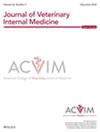Clinical characteristics associated with cervical hydrated nucleus pulposus extrusion in dogs
Abstract
Background
Clinical characteristics of cervical hydrated nucleus pulposus extrusion (HNPE) in dogs compared to other causes of cervical myelopathy are not well described.
Hypothesis/Objectives
To evaluate for clinical characteristics and mechanical ventilation likelihood associated with HNPE compared to other causes of cervical myelopathy.
Animals
Three hundred seventy-seven client-owned dogs from 2010 to 2022. Cases included 46 HNPE, 192 IVDE (intervertebral disc extrusion), 30 FCEM (fibrocartilaginous embolic myelopathy), 66 CSM (cervical spondylomyelopathy), and 43 neoplasia.
Methods
Retrospective study with record review and bivariate analyses. Dogs with signs of cervical myelopathy and an MRI diagnosis of HNPE, IVDE, FCEM, CSM, or neoplasia were included.
Results
When compared to dogs with other cervical myelopathies, dogs with HNPE were more likely to be older and of lower weight (median age 10 vs 8 years, P < .001; median weight 9.1 vs 20.2 kg, P < .001), be nonambulatory (89% vs 54%, P < .001), have signs of central cord syndrome (35% vs 16%, P = .002), and have nonlateralizing signs of myelopathy (65% vs 48%, P = .029). When compared to dogs with IVDE, dogs with HNPE were more likely to present with lower pain scores (30% vs 15% nonpainful, P = .002), and require mechanical ventilation (4/46 HNPE, 2/192 IVDE; odds ratio [OR] 9.0, 95% confidence interval [CI] 1.6-51.0).
Conclusions and Clinical Importance
Compared to dogs with other cervical myelopathies, dogs with HNPE have differences in clinical characteristics, presentation and likelihood of requiring mechanical ventilation. These differences are important to consider for case management.


 求助内容:
求助内容: 应助结果提醒方式:
应助结果提醒方式:


